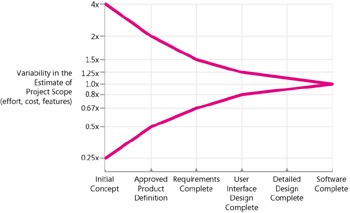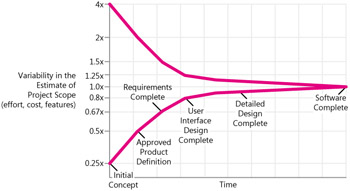4.2 The Cone of Uncertainty
4.2 The Cone of Uncertainty
Software development consists of making literally thousands of decisions about all the feature-related issues described in the previous section. Uncertainty in a software estimate results from uncertainty in how the decisions will be resolved. As you make a greater percentage of those decisions, you reduce the estimation uncertainty.
As a result of this process of resolving decisions, researchers have found that project estimates are subject to predictable amounts of uncertainty at various stages. The Cone of Uncertainty in Figure 4-1 shows how estimates become more accurate as a project progresses. (The following discussion initially describes a sequential development approach for ease of explanation. The end of this section will explain how to apply the concepts to iterative projects.)
The horizontal axis contains common project milestones, such as Initial Concept, Approved Product Definition, Requirements Complete, and so on. Because of its origins, this terminology sounds somewhat product-oriented. "Product Definition" just refers to the agreed-upon vision for the software, or the software concept, and applies equally to Web services, internal business systems, and most other kinds of software projects.

Figure 4-1: The Cone of Uncertainty based on common project milestones.
The vertical axis contains the degree of error that has been found in estimates created by skilled estimators at various points in the project. The estimates could be for how much a particular feature set will cost and how much effort will be required to deliver that feature set, or it could be for how many features can be delivered for a particular amount of effort or schedule. This book uses the generic term scope to refer to project size in effort, cost, features, or some combination thereof.
As you can see from the graph, estimates created very early in the project are subject to a high degree of error. Estimates created at Initial Concept time can be inaccurate by a factor of 4x on the high side or 4x on the low side (also expressed as 0.25x, which is just 1 divided by 4). The total range from high estimate to low estimate is 4x divided by 0.25x, or 16x!
One question that managers and customers ask is, "If I give you another week to work on your estimate, can you refine it so that it contains less uncertainty?" That's a reasonable request, but unfortunately it's not possible to deliver on that request. Research by Luiz Laranjeira suggests that the accuracy of the software estimate depends on the level of refinement of the software's definition (Laranjeira 1990). The more refined the definition, the more accurate the estimate. The reason the estimate contains variability is that the software project itself contains variability. The only way to reduce the variability in the estimate is to reduce the variability in the project.
One misleading implication of this common depiction of the Cone of Uncertainty is that it looks like the Cone takes forever to narrow—as if you can't have very good estimation accuracy until you're nearly done with the project. Fortunately, that impression is created because the milestones on the horizontal axis are equally spaced, and we naturally assume that the horizontal axis is calendar time.
In reality, the milestones listed tend to be front-loaded in the project's schedule. When the Cone is redrawn on a calendar-time basis, it looks like Figure 4-2.

Figure 4-2: The Cone of Uncertainty based on calendar time. The Cone narrows much more quickly than would appear from the previous depiction in Figure 4-1.
As you can see from this version of the Cone, estimation accuracy improves rapidly for the first 30% of the project, improving from ± 4x to ± 1.25x.
Can You Beat the Cone?
An important—and difficult—concept is that the Cone of Uncertainty represents the best-case accuracy that is possible to have in software estimates at different points in a project. The Cone represents the error in estimates created by skilled estimators. It's easily possible to do worse. It isn't possible to be more accurate; it's only possible to be more lucky.
| Tip #11 | Consider the effect of the Cone of Uncertainty on the accuracy of your estimate. Your estimate cannot have more accuracy than is possible at your project's current position within the Cone. |
EAN: 2147483647
Pages: 212